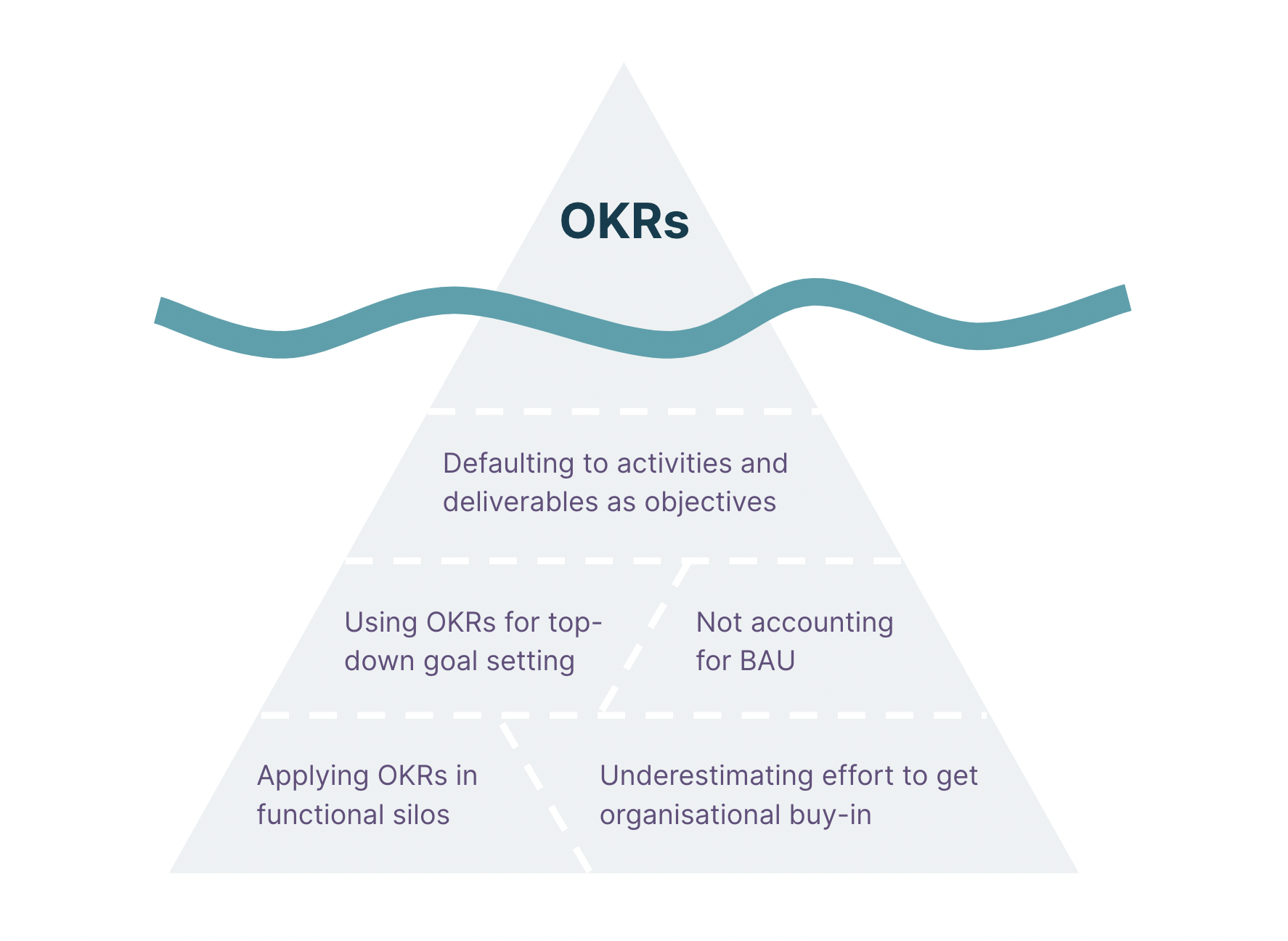The Objectives and Key Results (OKRs) method is powerful and popular. It has caught on across startups, large enterprises, and even non-profits. A big reason for this is the simplicity and accessibility of the method. ‘Objectives’ represent what to achieve, and ‘Key Results’ represent how we will know at the end of the quarter how much meaningful progress we have made. No complicated model, tooling, or jargon needed. Easy, right? Well, not quite.
If you’re considering adopting OKRs in your organization, it may be worth knowing when and how the simplicity of OKRs can be deceptive, and what some common gotchas are.
Here are a few to get you started:
Don’t default to activities and deliverables as objectives.
Objective can mean different things to different people. Is it my objective to do more than 45 minutes of exercise five times a week, or is my objective to lose X kilos of weight? Or is the real objective perhaps to improve my health and fitness? When choosing objectives, it’s easy to get sucked into only thinking of activities to complete or deliverables to produce, instead of meaningful outcomes to achieve. Asking a few 'Why' questions is a good way to get to a truly meaningful objective. Another reason why activities or deliverables can be easier to choose is that a quarter isn’t a lot of time, particularly for larger organizations. How can one define aspirational objectives when time is so limited? Consider that it’s perfectly fine for objectives to span multiple quarters. Key results under it can focus on the shorter-term progress towards the objectives.
OKRs don’t work when used for top-down goal setting.
If you’re doing some form of goal setting today, OKRs won’t necessarily be an easy transition. Especially if your current approach involves managers setting aggressive targets for their teams and direct reports, and pushing people hard to meet them. The OKR method is not old MBO wine in a digital age bottle. Each division, department, or team needs to be able to define their own OKRs, based on OKRs for the level above. 360° feedback, discussion, and debate is an important part of the process, but a clear sense of ownership of your own OKRs is essential. Is your organization ready for this change in mindset and work culture?
Business-as-usual (BAU) will likely get in the way.
At each level of cascading, OKRs are meant to inform the most strategic things which that team or group works on. Things that reflect a significant change to the status quo. These teams or groups will also need to continue working on BAU or keep the lights on (KLO) kind of work. For many teams, what they perceive to be BAU or KLO won’t leave much free capacity for strategic OKR-based work. For others, discretionary work will be misclassified as necessary BAU work because it has been historically considered ‘important’ or too much effort has already been invested in it. Consider publishing clear definitions of what types of work counts as BAU for your organization, group, or team. Also have teams review and question their current capacity allocation between BAU and strategic work.
OKRs will be a lot less effective in functional silos.
Many organizations still operate in traditional functional silos (even though they wouldn’t call them that). The power of aligning to outcomes via OKRs comes from enabling cross-functional collaboration on achievement of these outcomes. Teams should be able to deliver towards meaningful OKRs without getting mired in dependencies on other groups. While adopting OKRs will probably provide some benefits even in a functional organization, consider what small steps the organization can take towards executing in a cross-functional way. Make piloting those changes part of your OKR rollout plan.
Getting buy-in from the whole organization will likely be harder than you expect.
We find that OKRs and other outcome alignment methods can be helpful in communicating strategy to all levels of the organization. However OKRs alone won’t be sufficient in doing that. At each of the higher levels of the OKRs cascade, consider explicitly communicating why those OKRs are important in the organization’s current context. These why statements need to be framed in a way that resonates broadly within the organization, particularly for those in the trenches. Top-level OKRs will also need to be repeated, openly and honestly through multiple communication channels. Finding the right balance is tricky. Inadequate communication will lead to apathy (“oh, another management initiative that is going to take up my time”). Too much and you risk communication fatigue.


In summary, there are many good reasons to consider adopting OKRs but consider the not so obvious complexities involved. Especially ones that will require a mindset and culture shift, and a nuanced communication strategy. All these need careful consideration, planning, and capacity. And they need to be baked into your OKR adoption and rollout efforts.
Disclaimer: The statements and opinions expressed in this article are those of the author(s) and do not necessarily reflect the positions of Thoughtworks.


















